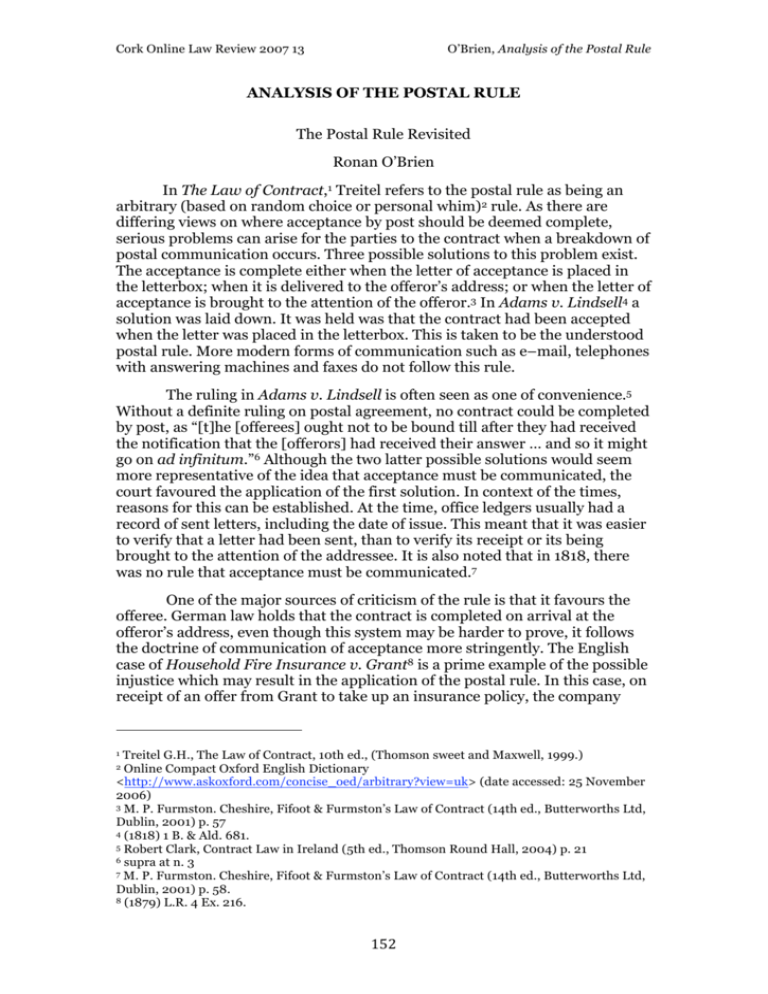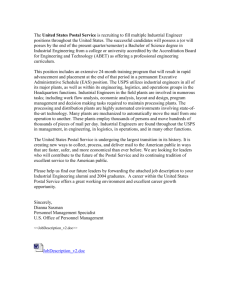Analysis of the Postal Rule
advertisement

Cork Online Law Review 2007 13 O’Brien, Analysis of the Postal Rule ANALYSIS OF THE POSTAL RULE The Postal Rule Revisited Ronan O’Brien In The Law of Contract,1 Treitel refers to the postal rule as being an arbitrary (based on random choice or personal whim)2 rule. As there are differing views on where acceptance by post should be deemed complete, serious problems can arise for the parties to the contract when a breakdown of postal communication occurs. Three possible solutions to this problem exist. The acceptance is complete either when the letter of acceptance is placed in the letterbox; when it is delivered to the offeror’s address; or when the letter of acceptance is brought to the attention of the offeror.3 In Adams v. Lindsell4 a solution was laid down. It was held was that the contract had been accepted when the letter was placed in the letterbox. This is taken to be the understood postal rule. More modern forms of communication such as e–mail, telephones with answering machines and faxes do not follow this rule. The ruling in Adams v. Lindsell is often seen as one of convenience.5 Without a definite ruling on postal agreement, no contract could be completed by post, as “[t]he [offerees] ought not to be bound till after they had received the notification that the [offerors] had received their answer … and so it might go on ad infinitum.”6 Although the two latter possible solutions would seem more representative of the idea that acceptance must be communicated, the court favoured the application of the first solution. In context of the times, reasons for this can be established. At the time, office ledgers usually had a record of sent letters, including the date of issue. This meant that it was easier to verify that a letter had been sent, than to verify its receipt or its being brought to the attention of the addressee. It is also noted that in 1818, there was no rule that acceptance must be communicated.7 One of the major sources of criticism of the rule is that it favours the offeree. German law holds that the contract is completed on arrival at the offeror’s address, even though this system may be harder to prove, it follows the doctrine of communication of acceptance more stringently. The English case of Household Fire Insurance v. Grant8 is a prime example of the possible injustice which may result in the application of the postal rule. In this case, on receipt of an offer from Grant to take up an insurance policy, the company Treitel G.H., The Law of Contract, 10th ed., (Thomson sweet and Maxwell, 1999.) Online Compact Oxford English Dictionary <http://www.askoxford.com/concise_oed/arbitrary?view=uk> (date accessed: 25 November 2006) 3 M. P. Furmston. Cheshire, Fifoot & Furmston’s Law of Contract (14th ed., Butterworths Ltd, Dublin, 2001) p. 57 4 (1818) 1 B. & Ald. 681. 5 Robert Clark, Contract Law in Ireland (5th ed., Thomson Round Hall, 2004) p. 21 6 supra at n. 3 7 M. P. Furmston. Cheshire, Fifoot & Furmston’s Law of Contract (14th ed., Butterworths Ltd, Dublin, 2001) p. 58. 8 (1879) L.R. 4 Ex. 216. 1 2 152 Cork Online Law Review 2007 13 O’Brien, Analysis of the Postal Rule posted back their acceptance. The letter never arrived. Grant was wholly unaware of the acceptance. It was held that a contract existed, and that he was liable to pay premiums. This example shows how, through application of the postal rule, a party may be bound by a contract without actual knowledge of its existence. If the rule stated that the contract would not be formed until receipt by the offeror, injustices like this could be avoided. According to Furmston it would also have been acceptable as a ruling in the Adams v. Lindsell case as “the defendants’ offer would not be revoked by their sale to third parties on 8th September.”9 This statement underpins the fact that the ruling was an arbitrary one, which was needed to make certain the law regarding acceptance by post at the time. The doctrine that communication of acceptance must be complete for a contract to be deemed binding could be said to be one of the greatest competitors of the postal rule in terms of forming a binding contract. Due to the predominance of modern forms of communication, for example fax, registered post (where receipt of acceptance is normally issued to the customer) and e–mail, the usage of the postal system in modern day business is waning. The above forms of communication, most of which are electronic telecommunication, are the most prevalent competition for the long established postal system. One of the earliest references of case law regarding electronic communications is Entores Ltd v. Miles Far East Corporation.10 This English case deals with an offer which was sent via the plaintiff’s telex machine to the defendants in Amsterdam. The acceptance was communicated back to London, by telex. The case was concerned with where the contract had come into existence. The English Court of Appeal held that the contract was concluded when the acceptance was received in London. This set a precedent which isolated electronic forms of communication from the authority of the postal rule. The principles of the Entores case were approved by the House of Lords in the case Brinkibon Ltd. v. Stahag Stahl und Stahlwarenhandelgesellschaft GmbH.11 Lord Wilberforce declared that he would accept it as a “general rule … but not necessarily a universal rule.”12 He believed that to avoid the injustice that might be caused by universal application of the rule, cases regarding instantaneous forms of communication must be resolved “by reference to the intention of the parties, by sound business practice and in some cases by a judgement where the risks should lie.” This lack of an irrefutable rule creates a margin for the types of cases which would otherwise be dealt with in an unjust manner. Application of this ratio would seem to be a logical way of dealing with electronic communications in a judicious manner. 9 M. P. Furmston. Cheshire, Fifoot & Furmston’s Law of Contract (14th ed., Butterworths Ltd, Dublin, 2001) p. 57. 10 (1955) 2 Q.B. 327. 11 (1983) 2 A.C. 34. 12 supra at 10 p. 296 153 Cork Online Law Review 2007 13 O’Brien, Analysis of the Postal Rule Another authority on communication of acceptance is the Electronic Commerce Act 2000, which deals specifically with communication through electronic means. Sections 20 and 21 specifically contain provisions relating to the time and place of the receipt of electronic communications, and the knowledge thereof. These provisions have more recently been superseded by the European Communities (Directive 2000/31 EC) Regulations 2003. Notwithstanding the Electronic Commerce Act 2000, Article 14 offers that “the order and the acknowledgement of receipt are deemed to be received when the parties to whom they are addressed are able to access them.”13 In other words, if an offeror provides an offer with an e–mail address for purposes of correspondence, the acceptance by the offeree is effective when it first becomes accessible by the offeror. These sources again sponsor the use of the general rule over the postal rule, even though as Hedley puts it, e–mail and paper mail are similar, in that they are both “asynchronous communication (which does not [require sender and recipient to act simultaneously]).”14 This is a contemporary example of how the postal rule is being dispensed with in favour of the more liberal general rule as applied in Brinkibon.15 Another challenger of the postal rule is The Vienna Convention on Contracts for the International Sale of Goods.16 This convention follows the general rule that an offer takes effect when it reaches the offeree17 and an acceptance takes effect when it reaches the offeror.18 Also, once the offer has been communicated, it cannot be revoked after the offeree has dispatched their acceptance.19 Treitel notes that these rules “[preserve] the English position that a posted acceptance prevails over a previously posted withdrawal.”20 This Convention could be seen as a compromise between the general rule and the postal rule, and its origins differ from that of the postal rule, which some might say was a ruling of convenience, chosen to make certain a previously untouched topic. In conclusion, the postal rule is seen as an arbitrary rule of convenience, which unduly favours the offeree. However, it originally had and still does perform a function, which is to create an acceptable precedent for dealing with postal communication of acceptance where none had previously existed. Even though this rule can create injustices such as explained in the earlier case of Household Fire Insurance v. Grant,21 this injustice can be avoided by including, as many modern contracts do, a standard notice clause European Communities (Directive 2000/31 EC) Regulations 2003. [S.I. No. 68 of 2003] Art. 14. (1) b. 14 Hedley. The Law of Electronic Commerce and the Internet in the UK and Ireland. (1st ed., Cavendish Publishing Ltd. London. 2006.) p. 246. 15 supra at 10. 16 Vienna Convention on Contracts for the International Sale of Goods (1980). 17 Art 15(1). 18 Art 18(2). 19 Art. 16(1). 20 Treitel G.H., The Law of Contract, 10th ed., (Thomson sweet and Maxwell, 1999.) p.28. 21 supra at n. 7. 13 154 Cork Online Law Review 2007 13 O’Brien, Analysis of the Postal Rule which would exempt the offeror from the jurisdiction of the postal rule. This can be done by declaring that the contract will only come into existence when it is received by the offeror, after the ordinary course of post has elapsed (one to two days in Ireland) or otherwise. Use of registered post presents itself as another alternative. As it is hand–delivered, one should either receive a receipt of delivery of the letter, or notice of a refusal to accept by the addressee. McDermott also suggests that where “the offeree has a choice of potential couriers, the courier selected may be viewed as the offeree’s agent,”22 which means the communication will not be complete until it is delivered to the offeror. The main competitor of the postal rule, namely the general rule of communication, is not without its shortcomings. As was expressed in Brinkibon by Lord Wilberforce, this general rule is not universal, especially when it involves instantaneous communications. So it can safely be said that with regards to practical application governing communication of acceptance, Treitel was indeed correct in saying that “[t]he rule is in truth an arbitrary one, little better or worse than its competitors.” 22 McDermott, P. Contract Law (Butterworths/LexisNexis, 2001) p.49 155






